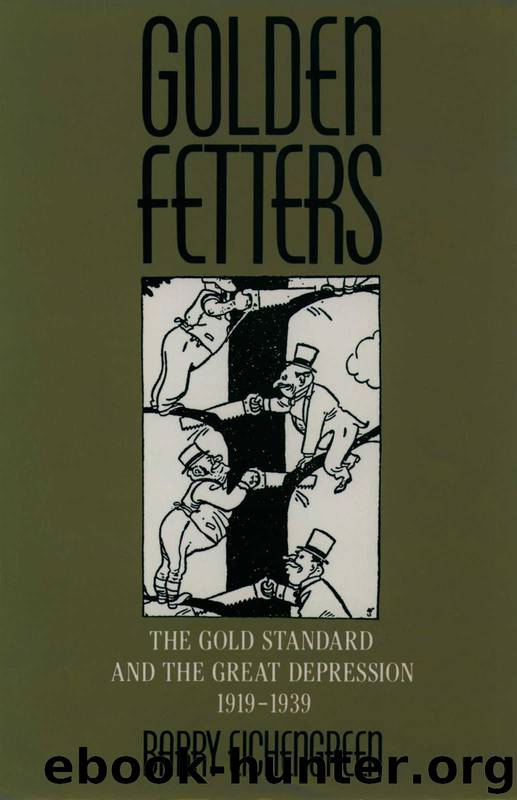Golden Fetters: The Gold Standard and the Great Depression, 1919-1939 by Barry Eichengreen

Author:Barry Eichengreen
Language: eng
Format: azw3
Tags: Business & Economics, Economic History
ISBN: 9780195101133
Publisher: Oxford University Press
Published: 1995-01-15T01:26:05+00:00
European Repercussions
Once the Fed's open market purchases were halted, gold outflows ceased and gave way to inflows. American gold imports applied additional pressure to countries with relatively weak balance of payments positions. French gold imports compounded their difficulties. With economic activity and hence the demand for money holding up relatively well, the Bank of France gained gold throughout 1930. Yet her domestic assets remained virtually unchanged between the beginning and end of the calendar year. France was still immune to the economic slump. Pressure for a more liberal credit policy was therefore all but nonexistent. The notion that the central bank should adopt an “unsound” monetary policy was antithetical to French officials. Monetary expansion conjured up images of inflation and social turmoil like that last experienced in 1926. As early as January 1930, the Council of Regents of the Bank of France warned that the “extreme abundance” of money in France threatened to provoke a new round of inflation.73
To prevent such an eventuality, new statutes had been adopted in 1928 to prohibit the Bank of France from conducting most open market operations.74 Though it still was possible to reduce the discount rate, that instrument had relatively little impact on domestic credit conditions, since the French discount market was narrow.75 Each additional franc of gold therefore increased the note circulation by only a franc rather than by nearly three francs as theoretically permissible under the 35 percent proportional cover system. If commercial banks repaid rediscounts with the central bank as alternative uses for their funds began to dry up, the domestic assets of the central bank might fail to grow despite the inflow of gold.
Foreign critics such as Ralph Hawtrey criticized Moreau and his colleagues for failing to build “a structure of credit” on their gold imports. By failing to expand domestic credit and to repel gold inflows, they argued, the French had violated the rules of the gold standard game. To facilitate credit expansion. Hawtrey urged changes in the statutes under which the Bank of France operated.76 Such recommendations failed to take into account the fear of inflation that remained paramount in the minds of the French electorate.
In fact, French policymakers regarded measures to reverse the deflation as counterproductive. They ascribed the Depression to overly expansionary monetary policies supported by the accumulation of foreign exchange reserves. How else, after all, could the global gold standard have been restored in 1925 when American prices were still 60 percent above 1913 levels?77 Now that foreign exchange reserves were being liquidated, the necessary deflationary adjustment could finally take place. To frustrate its completion would only set the stage for another speculative boom and, ultimately, an even more disastrous crash.78
Yet the French economy was not entirely immune to international flows of gold. Gold inflows led to the growth of currency in the hands of the public. This —Sioux City Tribune kept demand and prices relatively high. French consumers consequently continued to import goods from abroad despite the decline of exports. France's trade deficit consequently widened from less than 4 percent of imports in 1928 to 12 percent in 1929 and 18 percent in 1930.
Download
This site does not store any files on its server. We only index and link to content provided by other sites. Please contact the content providers to delete copyright contents if any and email us, we'll remove relevant links or contents immediately.
International Integration of the Brazilian Economy by Elias C. Grivoyannis(90714)
The Radium Girls by Kate Moore(11921)
Turbulence by E. J. Noyes(7935)
Nudge - Improving Decisions about Health, Wealth, and Happiness by Thaler Sunstein(7615)
The Black Swan by Nassim Nicholas Taleb(7010)
Rich Dad Poor Dad by Robert T. Kiyosaki(6399)
Pioneering Portfolio Management by David F. Swensen(6226)
Man-made Catastrophes and Risk Information Concealment by Dmitry Chernov & Didier Sornette(5921)
Zero to One by Peter Thiel(5684)
Secrecy World by Jake Bernstein(4642)
Millionaire: The Philanderer, Gambler, and Duelist Who Invented Modern Finance by Janet Gleeson(4374)
The Age of Surveillance Capitalism by Shoshana Zuboff(4209)
Skin in the Game by Nassim Nicholas Taleb(4161)
Bullshit Jobs by David Graeber(4094)
The Money Culture by Michael Lewis(4074)
Skin in the Game: Hidden Asymmetries in Daily Life by Nassim Nicholas Taleb(3929)
The Dhandho Investor by Mohnish Pabrai(3698)
The Wisdom of Finance by Mihir Desai(3650)
Blockchain Basics by Daniel Drescher(3495)
